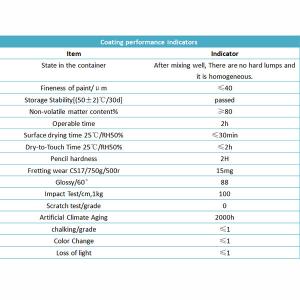Application of polyaspartic resin in the preparation of high solid acrylic polyurethane coatings
Add to Cart
The concept of "dual-carbon" goals underscores China's role and commitment as a global player. It is also prompting a transformation in Chinese industries, with carbon emission management taking center stage. For companies specializing in coatings, the priority in formulating new products now hinges on enhancing performance while minimizing volatile organic compounds (VOCs).
Acrylic polyurethane coatings are a go-to material for outdoor anti-corrosion topcoats. However, some of the resins currently in use have low solid content, resulting in less-than-ideal film thickness and significant environmental pollution due to the release of organic volatiles. Despite technological advances introducing hydroxypropyl resins with 80% solid content, their high viscosity and low reactivity still necessitate the use of large quantities of solvents. Consequently, the actual construction may still contain up to 70% solids, emitting a considerable amount of VOCs.
Feiyang's newly developed solvent-free, low-viscosity polyaspartic resin offers a solution to this problem. It effectively reduces VOC levels and accelerates the drying process in acrylic polyurethane coatings, while also enhancing the mechanical properties of the coating film.
Polyaspartic ester resin, commonly known as "polyaspartic resin," is a solvent-free, low-viscosity material that also boasts excellent weather resistance, corrosion resistance, and abrasion resistance. In recent years, it has gained traction in various applications such as waterproofing, anti-corrosion, and flooring.
From a chemical standpoint, polyaspartic resin is an aliphatic secondary amine. It belongs to a category of materials synthesized through the Michael addition of maleic acid esters and primary diamines. The synthesis principle is illustrated in the figure below:
Reaction principle of polyaspartic resin synthesis
Due to the abundance and variety of diamine main chain structures (X), common polyaspartic resin main chain (X) structures are as follows:
Polyaspartic resin main chain (X) structure
The performance of acrylic polyurethane coatings can be tailored to meet various requirements by selecting polyaspartic resins with different characteristics. Generally, polyaspartic resins offer the following advantages when used in an acrylic polyurethane system:
- Reduction of Viscosity and VOC Content
Polyaspartic resin typically has a solid content of about 96% and is compatible with hydroxypropyl resin. When incorporated into hydroxypropyl-based coatings, it can increase the system's solid content, reaching up to 85% during application. As a low-viscosity aminocompound with molecular sizes ranging from 60cps to 1000cps, polyaspartic resin effectively dilutes the coating mixture, thus reducing VOC levels and enhancing film thickness.
- Accelerated Drying Speed
Acrylic polyurethane coatings usually take around 24 hours to dry. Under low temperatures or low hydroxyl activity, they require high-temperature curing. Polyaspartic resin, when combined with HDI trimers, has a gel time ranging from 2 to 130 minutes. The molecular structure features a sterically hindered secondary amino group, which is more reactive than hydroxyl groups. When blended with hydroxypropyl resin, it speeds up the drying process, allowing the coating to reach a sandable and polishable hardness within a few hours. Even at low temperatures (-15 degrees Celsius), the coating can air-dry without the need for baking, thereby conserving energy and reducing emissions.
These attributes have been confirmed through experimentation. A coating film was prepared by mixing Zhanxin's high solid content hydroxyacrylic resin 1753 and our proprietary polyaspartic resin F420 in a specific ratio with HDI trimer. The results validated the performance benefits outlined above.
Based on the test results, it's evident that polyaspartic resin substantially enhances the solid content, drying speed, and mechanical properties of acrylic polyurethane coatings. Depending on performance requirements, various formulations of polyaspartic resin can be blended with hydroxypropyl resin to create coatings with specific attributes.
Currently, this approach has found extensive applications in industries such as automotive repair, aviation, heavy machinery, and outdoor steel structures. It has significantly advanced the realization of "dual-carbon" goals, contributing to a more sustainable future.
Feiyang has been specializing in the production of raw materials for polyaspartic coatings for 30 years and can provide polyaspartic resins, hardeners and coating formulations. Some of our polyaspartic coating formulations: Polyaspartic Coating
Feel free to contact us: marketing@feiyang.com.cn
Our products list:
Learn more polyaspartic knowledge: Polyaspartic FAQ




